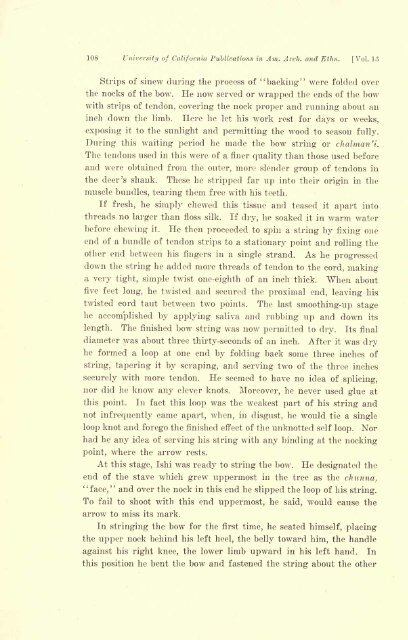Saxton Pope - Yahi Archery.pdf - Primitiv-bogen.de
Saxton Pope - Yahi Archery.pdf - Primitiv-bogen.de
Saxton Pope - Yahi Archery.pdf - Primitiv-bogen.de
You also want an ePaper? Increase the reach of your titles
YUMPU automatically turns print PDFs into web optimized ePapers that Google loves.
108 University of California Publications in Am. Arch, and Ethn. [Vol. 13Strips of sinew during the process of "backing" were fol<strong>de</strong>d overthe nocks of the bow. He now served or wrapped the ends of the bowwith strips of tendon, covering the nock proper and running about aninch down the limb. Here he let his work rest for days or weeks,exposing itto the sunlight and permitting the wood to season fully.During this waiting period he ma<strong>de</strong> the bow string or chalman i.The tendons used in this were of a finer quality than those used beforeand were obtained from the outer, more slen<strong>de</strong>r groupof tendons inthe <strong>de</strong>er s shank. These he stripped far up into their origin in themuscle bundles, tearing them free with his teeth.If fresh, he simply chewed this tissue and teased it apart intothreads no larger than floss silk. If dry, he soaked it in warm waterbefore chewing He it. then procee<strong>de</strong>d to spin a string by fixing oneend of a bundle of tendon strips to a stationary point and rolling theother end between his fingers in a single strand. As he progresseddown the string he ad<strong>de</strong>d more threads of tendon to the cord, makinga very tight, simple twist one-eighth of an inch thick. When aboutfive feet long, he twisted and secured the proximal end, leaving histwisted cord taut between two points. The last smoothing-up stagehe accomplished by applying saliva and rubbing up and down itslength. The finished bow string was now permitted to dry. Its finaldiameter was about three thirty-seconds of an inch. After it was dryhe formed a loop at one end by folding back some three inches ofstring, tapering it by scraping, and serving two of the three inchessecurely with more tendon. He seemed to have no i<strong>de</strong>a of splicing,nor did he know any clever knots. Moreover, he never used glue atthis point. In fact this loop was the weakest part of his string andnot infrequently came apart, when, in disgust, he would tie a singleloop knot and forego the finished effect of the unknotted self loop. Norhad he any i<strong>de</strong>a of serving his string with any binding at the nockingpoint, where the arrow rests.At this stage, Ishi was ready to string the bow.end of the stave which grew uppermostHe <strong>de</strong>signated thein the tree as the chunna,and over the nock in this end he slipped the loop of his string."face,"To fail to shoot with this end uppermost, he said, would cause thearrow to miss its mark.In stringing the bow for the first time, he seated himself, placingthe upper nock behind his left heel, the belly toward him, the handleagainst his right knee, the lower limb upwardin his left hand. Inthis position he bent the bow and fastened the string about the other


